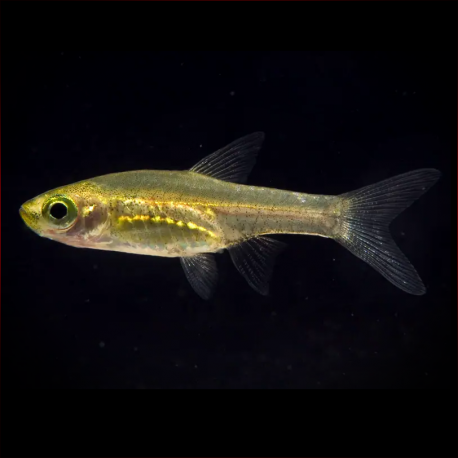More info
Datasheet
| Minimum Tank Size | 40 litres / 10.57 US gallons |
| Maximum Size | 3.0cm / 1.18inches |
| Temperature | 20°C / 68.00°F - 26°C / 78.80°F |
| Hardness | 2.02dgH / 36ppm - 12.05dgH / 215ppm |
| pH | 5.5-7.5 |
General Description
The Horadandia Atukorali species belongs to the Cyprinidae family and is characterized by its small size of up to 3.0cm, moderately compressed elongated body, and absence of barbels, a lateral line, and a symphyseal knob on the lower jaw. It is a peaceful fish that prefers still or slow-moving waters and is often found in nutrient-poor habitats like forest peat swamps. The anatomical structure of this species is a result of miniaturization, a process common among certain cyprinid taxa where sexually mature adults exhibit significantly reduced sizes.
Aquarium Setup
Horadandia Atukorali does best in a densely planted tank with floating plants and driftwood to provide natural cover and shade. Gentle filtration is recommended, and the addition of other diminutive species is ideal for its tank companionship. This schooling species thrives in groups of at least 10-12 individuals to reduce stress and display natural behaviors.
Behaviour
This species displays peaceful behavior but is timid and does not fare well as a community fish due to its small size. In a group setting, males exhibit vibrant colors and compete with each other for female attention. It is an excellent companion for small, shy anabantoids and can coexist with freshwater shrimp in a planted aquarium.
Feeding and Diet
Horadandia Atukorali is a micropredator, feeding on small insects, worms, crustaceans, and zooplankton in its natural habitat. In captivity, it accepts small live and frozen foods such as Daphnia, Artemia, and Moina, along with quality flakes and granules. A varied diet enhances coloration and promotes breeding conditions.
Reproduction & Dimorphism
Breeding this species in captivity is achievable as they are egg-scattering, continuous spawners with no parental care. Fry can be raised in a separate container with fine-leaved plants. Mature females are larger and rounder-bellied than males, exhibiting visible dimorphism.
Habitat and Distribution
Native to Sri Lanka and southern India, Horadandia Atukorali is commonly found in sluggish waters like rice paddies, swamps, and weedy ponds. It is mainly restricted to Kerala, Tamil Nadu states, and the Union State of Puducherry, with some subspecies described in specific locations such as Pathiramanal Island, Vembanad Lake, Kerala.

